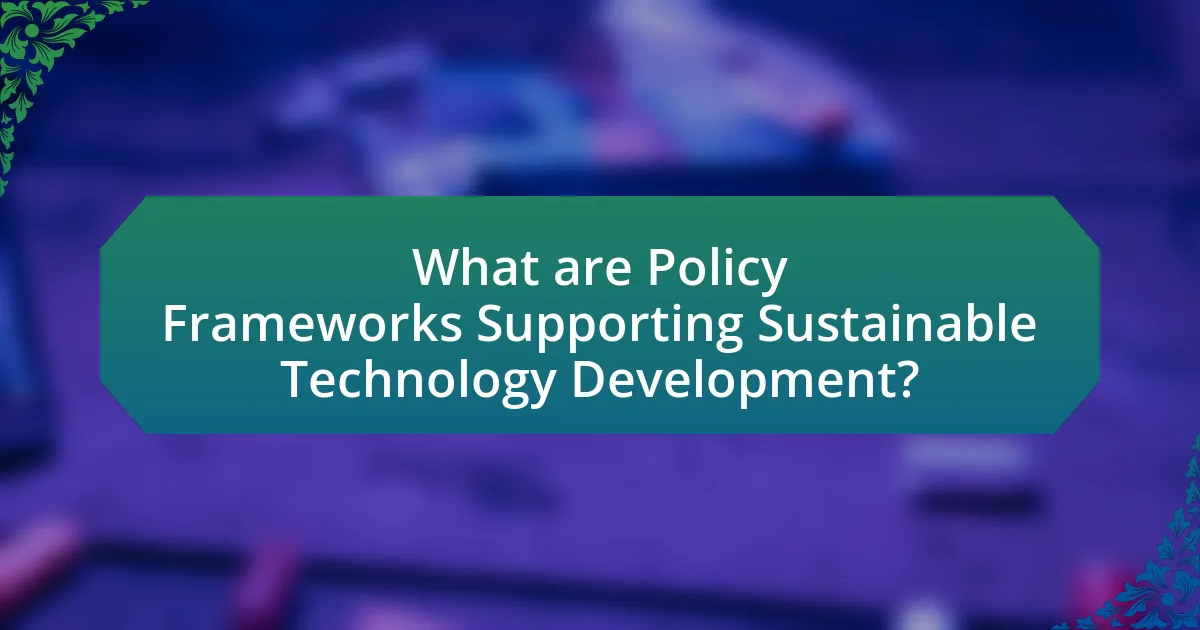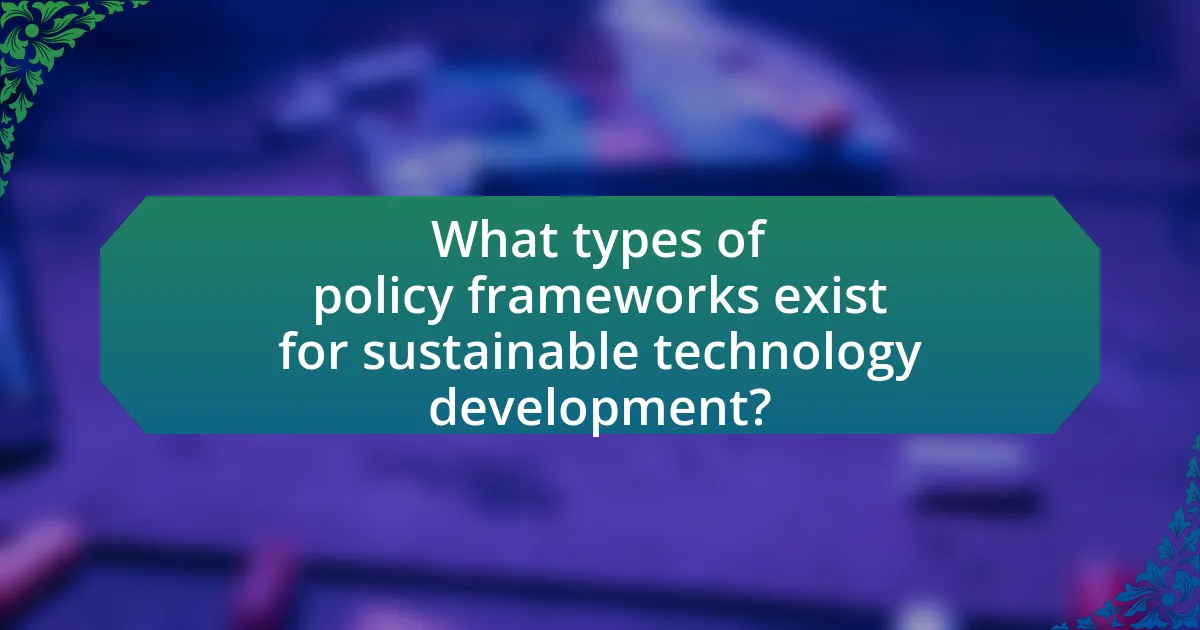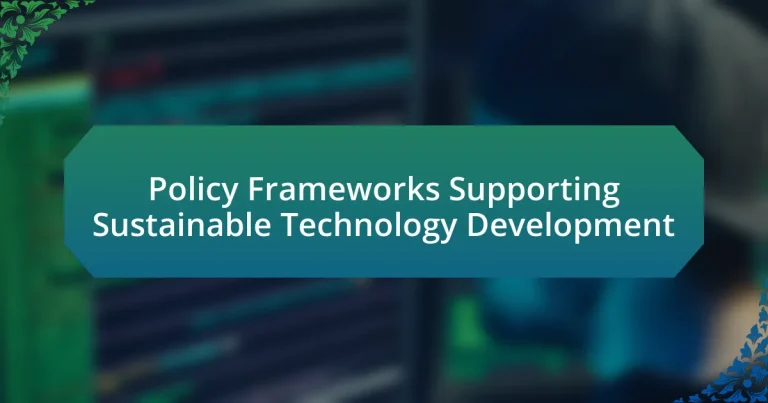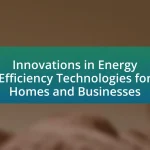Policy frameworks supporting sustainable technology development encompass regulations, guidelines, and initiatives aimed at promoting environmentally friendly practices and innovations. These frameworks, such as the European Union’s Green Deal and the United Nations’ Sustainable Development Goals, play a crucial role in influencing sustainable technology by establishing clear objectives, stakeholder engagement, and evidence-based decision-making. Effective frameworks include regulatory, incentive-based, and collaborative types, each addressing environmental and social concerns while fostering innovation. Challenges in implementation arise from conflicting interests, financial constraints, and the need for adaptability in response to rapid technological changes. Overall, these frameworks are essential for guiding investments and ensuring that technological advancements align with sustainability goals.

What are Policy Frameworks Supporting Sustainable Technology Development?
Policy frameworks supporting sustainable technology development include regulations, guidelines, and initiatives designed to promote environmentally friendly practices and innovations. These frameworks often encompass government policies, international agreements, and industry standards that encourage the adoption of sustainable technologies. For instance, the European Union’s Green Deal aims to make Europe climate-neutral by 2050, promoting investments in renewable energy and sustainable practices. Additionally, the United Nations’ Sustainable Development Goals provide a global blueprint for achieving a better and more sustainable future, emphasizing the importance of technology in addressing climate change and fostering sustainable economic growth.
How do these policy frameworks influence sustainable technology?
Policy frameworks significantly influence sustainable technology by establishing regulations, incentives, and standards that promote environmentally friendly practices. These frameworks guide investments in renewable energy, encourage research and development in sustainable materials, and set emissions reduction targets, which collectively drive innovation in sustainable technologies. For instance, the European Union’s Green Deal aims to make Europe climate-neutral by 2050, thereby incentivizing the adoption of clean technologies and fostering a competitive market for sustainable solutions.
What are the key components of effective policy frameworks?
The key components of effective policy frameworks include clear objectives, stakeholder engagement, evidence-based decision-making, adaptability, and implementation mechanisms. Clear objectives provide a focused direction for policy initiatives, ensuring that goals are well-defined and measurable. Stakeholder engagement involves collaboration with relevant parties, fostering inclusivity and support for the policy. Evidence-based decision-making relies on data and research to inform policies, enhancing their effectiveness and credibility. Adaptability allows frameworks to evolve in response to changing circumstances and new information, ensuring long-term relevance. Finally, implementation mechanisms outline the processes and resources necessary to execute the policy effectively, ensuring that objectives are met. These components collectively contribute to the success of policy frameworks in promoting sustainable technology development.
How do these components interact to promote sustainability?
The components of policy frameworks, technological innovation, and stakeholder engagement interact synergistically to promote sustainability. Policy frameworks establish regulations and incentives that guide technological development towards sustainable practices, ensuring compliance with environmental standards. Technological innovation provides the tools and solutions necessary for reducing resource consumption and minimizing waste, while stakeholder engagement fosters collaboration among governments, businesses, and communities, enhancing the effectiveness of sustainability initiatives. For example, the European Union’s Green Deal integrates these components by setting ambitious climate targets, promoting clean technologies, and involving various stakeholders in the decision-making process, thereby driving a collective effort towards sustainability.
Why are policy frameworks essential for sustainable technology development?
Policy frameworks are essential for sustainable technology development because they provide structured guidelines that promote innovation while ensuring environmental protection and social equity. These frameworks establish regulatory standards, incentivize investment in green technologies, and facilitate collaboration among stakeholders, which are critical for achieving long-term sustainability goals. For instance, the European Union’s Green Deal aims to make Europe climate-neutral by 2050, demonstrating how policy frameworks can drive significant advancements in sustainable technology through clear targets and funding mechanisms.
What challenges do policymakers face in implementing these frameworks?
Policymakers face significant challenges in implementing frameworks for sustainable technology development, primarily due to conflicting interests among stakeholders. These conflicts often arise between economic growth objectives and environmental sustainability goals, making it difficult to achieve consensus. Additionally, limited financial resources hinder the ability to invest in necessary infrastructure and technology. According to a report by the International Energy Agency, over $4 trillion is needed annually to meet global energy transition goals, highlighting the financial burden on policymakers. Furthermore, the complexity of regulatory environments can lead to delays and inefficiencies in the implementation process, as seen in various countries where bureaucratic hurdles have stalled progress. Lastly, the rapid pace of technological change poses a challenge for policymakers to keep regulations relevant and effective, as outdated frameworks can impede innovation and adaptation.
How do these frameworks address environmental and social concerns?
These frameworks address environmental and social concerns by integrating sustainability principles into policy development and implementation. For instance, many frameworks promote the adoption of renewable energy sources, which significantly reduce greenhouse gas emissions, thereby mitigating climate change impacts. Additionally, they often include social equity measures, ensuring that marginalized communities have access to sustainable technologies and resources. Evidence of this can be seen in the European Union’s Green Deal, which aims to make Europe climate-neutral by 2050 while also addressing social inequalities through initiatives like the Just Transition Fund, designed to support regions and workers affected by the transition to a green economy.

What types of policy frameworks exist for sustainable technology development?
Various types of policy frameworks exist for sustainable technology development, including regulatory frameworks, incentive-based frameworks, and collaborative frameworks. Regulatory frameworks establish mandatory standards and guidelines that govern technology development, such as emissions regulations and safety standards, which ensure compliance with environmental and social objectives. Incentive-based frameworks provide financial or non-financial incentives, such as tax credits or grants, to encourage the adoption of sustainable technologies. Collaborative frameworks promote partnerships among government, industry, and academia to foster innovation and share best practices in sustainable technology development. These frameworks are essential for guiding investments and ensuring that technological advancements align with sustainability goals.
How do regulatory frameworks differ from voluntary frameworks?
Regulatory frameworks are legally binding rules established by governmental bodies, while voluntary frameworks are guidelines or standards that organizations choose to adopt without legal obligation. Regulatory frameworks enforce compliance through penalties and legal repercussions, ensuring adherence to specific laws, such as environmental regulations mandated by the Clean Air Act. In contrast, voluntary frameworks, like ISO 14001 for environmental management, encourage best practices and sustainability but lack enforcement mechanisms, relying instead on organizational commitment and stakeholder pressure. This distinction highlights the varying levels of obligation and enforcement associated with each type of framework in the context of sustainable technology development.
What are the advantages and disadvantages of regulatory frameworks?
Regulatory frameworks provide structured guidelines that can enhance compliance, promote safety, and foster innovation, while also imposing constraints that may hinder flexibility and increase operational costs. The advantages include ensuring public safety and environmental protection, as seen in regulations like the Clean Air Act, which has significantly reduced air pollution levels in the United States since its enactment in 1970. Additionally, regulatory frameworks can stimulate market growth by creating standards that encourage investment in sustainable technologies. Conversely, disadvantages include the potential for bureaucratic inefficiencies and the burden of compliance costs, which can disproportionately affect smaller businesses. For instance, the European Union’s REACH regulation, aimed at chemical safety, has faced criticism for its complexity and high compliance costs, which can stifle innovation among smaller firms.
How do voluntary frameworks encourage innovation?
Voluntary frameworks encourage innovation by providing organizations with flexible guidelines that promote experimentation and creativity. These frameworks, such as ISO standards or industry-specific best practices, allow companies to adopt innovative practices without the constraints of mandatory regulations. For example, the ISO 14001 standard encourages organizations to develop environmental management systems, which can lead to innovative approaches in sustainability and resource efficiency. Research indicates that companies adhering to voluntary frameworks often experience increased competitiveness and improved operational efficiencies, as they are incentivized to explore new technologies and processes that align with the framework’s principles.
What role do international agreements play in shaping these frameworks?
International agreements play a crucial role in shaping policy frameworks that support sustainable technology development by establishing common standards, goals, and cooperative mechanisms among nations. These agreements, such as the Paris Agreement on climate change, set binding commitments that encourage countries to adopt sustainable practices and technologies. For instance, the Paris Agreement aims to limit global warming to well below 2 degrees Celsius, prompting nations to develop and implement policies that promote renewable energy and reduce greenhouse gas emissions. This collaborative approach fosters innovation and investment in sustainable technologies, as countries align their policies with international expectations and share best practices.
How do global initiatives influence national policies?
Global initiatives influence national policies by establishing frameworks and standards that countries adopt to align with international goals. For instance, the Paris Agreement on climate change compels nations to set and pursue greenhouse gas reduction targets, thereby shaping domestic environmental policies. Research shows that countries participating in such initiatives often experience increased investment in sustainable technologies, as seen in the European Union’s Green Deal, which aims to make Europe climate-neutral by 2050. This alignment with global initiatives not only fosters cooperation but also encourages nations to implement policies that support sustainable development, reflecting a collective commitment to addressing global challenges.
What examples of successful international collaborations exist?
Successful international collaborations include the Paris Agreement, where 196 countries committed to combat climate change by limiting global warming to below 2 degrees Celsius. This agreement exemplifies a unified global effort to address environmental challenges through shared policies and frameworks. Another example is the International Space Station (ISS), a joint project involving NASA, Roscosmos, ESA, JAXA, and CSA, which fosters scientific research and technological advancements in space exploration through collaborative efforts across nations. These collaborations demonstrate effective partnerships that leverage diverse resources and expertise to achieve common goals in sustainable technology development.

How can stakeholders effectively engage with policy frameworks?
Stakeholders can effectively engage with policy frameworks by actively participating in the policy-making process, providing feedback, and collaborating with policymakers. Engaging stakeholders early in the development of policy frameworks ensures that diverse perspectives are considered, which can lead to more comprehensive and effective policies. For instance, the United Nations Framework Convention on Climate Change (UNFCCC) emphasizes stakeholder involvement in climate policy, demonstrating that inclusive engagement can enhance policy relevance and acceptance. Additionally, research shows that stakeholder engagement can improve the implementation of policies, as seen in the case of the European Union’s Horizon 2020 program, where stakeholder input has been crucial in shaping research and innovation agendas.
What strategies can businesses adopt to align with these frameworks?
Businesses can adopt strategies such as integrating sustainability into their core operations, engaging in stakeholder collaboration, and leveraging technology for efficiency to align with policy frameworks supporting sustainable technology development. By embedding sustainability into their business models, companies can ensure compliance with regulations and enhance their market competitiveness. Engaging with stakeholders, including government bodies and NGOs, fosters collaboration that can lead to innovative solutions and shared resources. Additionally, utilizing advanced technologies, such as renewable energy systems and sustainable supply chain practices, can significantly reduce environmental impact while meeting regulatory standards. These strategies are validated by numerous studies indicating that businesses that prioritize sustainability often experience improved financial performance and brand loyalty.
How can companies measure their compliance with policy frameworks?
Companies can measure their compliance with policy frameworks by conducting regular audits and assessments against established criteria. These assessments typically involve evaluating internal processes, documentation, and employee adherence to the policies outlined in the framework. For instance, organizations can utilize compliance management software that tracks adherence to specific regulations and standards, providing real-time data on compliance status. Additionally, benchmarking against industry standards and best practices can offer insights into areas of non-compliance. Research indicates that companies that implement systematic compliance measurement strategies, such as the use of key performance indicators (KPIs), are more likely to achieve higher compliance rates and mitigate risks associated with non-compliance.
What best practices should organizations follow to advocate for sustainable policies?
Organizations should adopt a multi-faceted approach to advocate for sustainable policies, focusing on stakeholder engagement, transparency, and evidence-based advocacy. Engaging stakeholders, including employees, customers, and community members, fosters collaboration and ensures diverse perspectives are considered in policy development. Transparency in operations and decision-making builds trust and encourages public support for sustainability initiatives. Evidence-based advocacy, supported by data and research, strengthens the case for sustainable policies by demonstrating their economic, environmental, and social benefits. For instance, a study by the World Resources Institute found that companies implementing sustainable practices can reduce costs by up to 20% while enhancing their brand reputation.
What resources are available for understanding and implementing these frameworks?
Resources available for understanding and implementing policy frameworks supporting sustainable technology development include academic journals, government publications, and online platforms. Academic journals such as “Environmental Science & Policy” and “Sustainability” provide peer-reviewed articles that analyze various frameworks and their effectiveness. Government publications, like the United Nations’ “2030 Agenda for Sustainable Development,” outline international guidelines and best practices. Online platforms, including the World Resources Institute and the International Institute for Sustainable Development, offer toolkits, case studies, and webinars that facilitate practical implementation of these frameworks. These resources collectively provide comprehensive insights and actionable strategies for stakeholders involved in sustainable technology development.
Where can stakeholders find relevant research and case studies?
Stakeholders can find relevant research and case studies in academic journals, government publications, and industry reports focused on sustainable technology development. For instance, the journal “Sustainable Technology and Policy” publishes peer-reviewed articles that explore various aspects of sustainable technology frameworks. Additionally, the United Nations Environment Programme (UNEP) provides case studies and reports on policy frameworks that support sustainable development initiatives. These sources are credible and regularly updated, ensuring stakeholders have access to the latest findings and examples in the field.
How can training programs enhance understanding of sustainable technology policies?
Training programs can enhance understanding of sustainable technology policies by providing structured education on the principles, practices, and implications of these policies. These programs often include case studies, expert lectures, and hands-on activities that illustrate the real-world applications and benefits of sustainable technologies. For instance, research conducted by the International Renewable Energy Agency (IRENA) indicates that targeted training can improve knowledge retention and application of sustainable practices among participants, leading to better policy implementation. Additionally, training programs foster collaboration and networking among stakeholders, which can facilitate the sharing of best practices and innovative solutions in sustainable technology.
What are the future trends in policy frameworks for sustainable technology development?
Future trends in policy frameworks for sustainable technology development include increased integration of circular economy principles, enhanced regulatory support for green technologies, and a focus on public-private partnerships. These trends are driven by the need to address climate change and resource depletion, as evidenced by the European Union’s Green Deal, which aims to make Europe climate-neutral by 2050 through comprehensive policy measures. Additionally, countries are adopting more stringent emissions targets and incentivizing innovation in sustainable technologies, as seen in the United States’ Inflation Reduction Act, which allocates significant funding for clean energy initiatives. These evolving frameworks reflect a global shift towards sustainability, emphasizing collaboration and innovation as key components for future development.
How might emerging technologies influence policy creation?
Emerging technologies significantly influence policy creation by providing new tools and data that enhance decision-making processes. For instance, the integration of artificial intelligence in data analysis allows policymakers to assess social trends and public needs more accurately, leading to more informed and responsive policies. Additionally, technologies such as blockchain can enhance transparency and accountability in governance, which can shape regulatory frameworks. A study by the World Economic Forum highlights that the adoption of digital technologies in governance can improve public service delivery and citizen engagement, demonstrating the tangible impact of these technologies on policy development.
What role will public opinion play in shaping future policies?
Public opinion will significantly influence future policies by guiding decision-makers on public priorities and values. Policymakers often rely on public sentiment to justify and shape legislation, particularly in areas like sustainable technology development, where community support can drive funding and implementation. For instance, surveys indicate that a majority of citizens favor renewable energy initiatives, prompting governments to prioritize policies that support solar and wind energy projects. This alignment between public opinion and policy not only reflects democratic principles but also enhances the legitimacy and effectiveness of the policies enacted.




